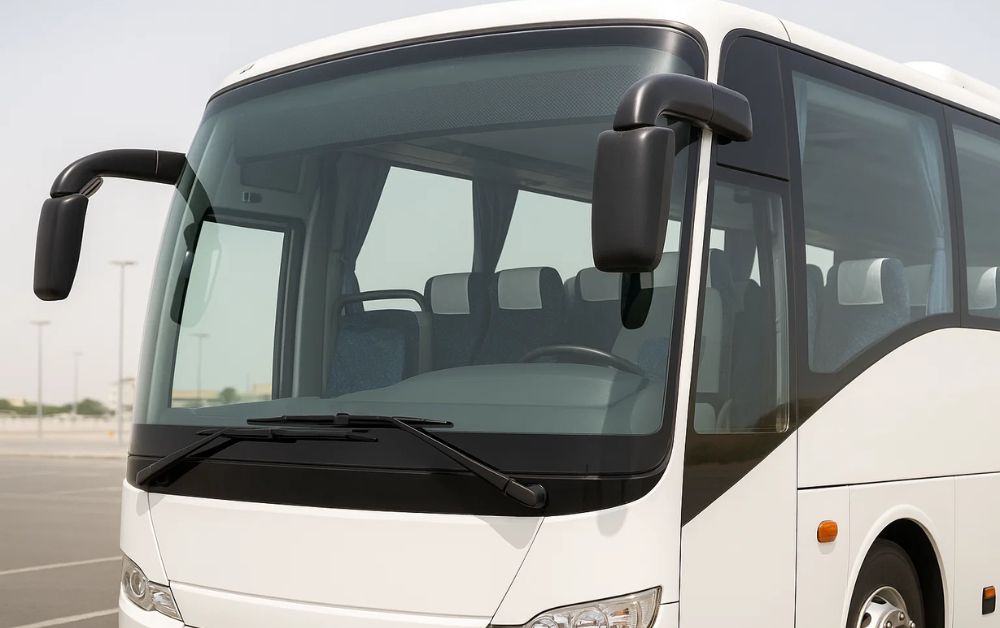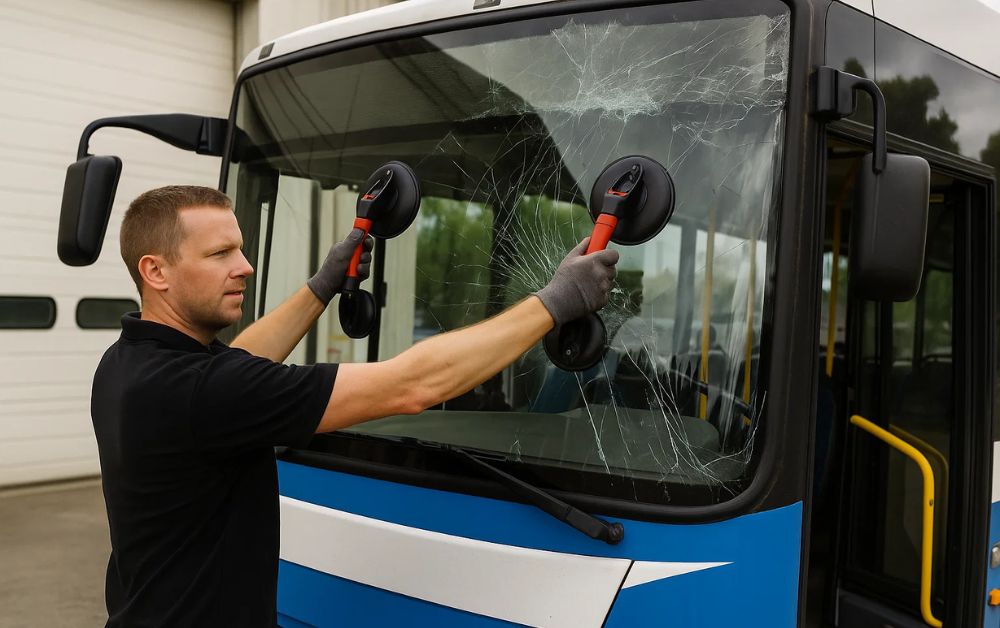In the dynamic transport environment of Abu Dhabi, buses form a crucial part of public and private transit systems. Whether it’s public transportation fleets, school buses, or private tourist coaches, maintaining safety and visibility through proper glass installation and timely replacement is paramount. The bus glass is not merely for show or a view—its use contributes significantly to structural integrity, safety, and passenger comfort. This blog discusses the various glasses utilized in buses. It offers an in-depth overview of the replacement process for glass used in buses Abu Dhabi, including observations on industry and local service standards.

Types of Glass Used in Buses
Bus glass is designed to comply with safety, performance, and durability requirements. The most prevalent kinds of glass used in buses:
1. Tempered Glass
Tempered or toughened glass is commonly used in buses’ windows. It’s created by heating regular glass and cooling it quickly, making it much stronger. When the tempered glass breaks, it does so in tiny blunt pieces that minimize the risk of harm.
Where it’s applied: Side windows, back windows.
Benefits:
- High impact resistance
- It breaks into harmless granules.
- Low cost and easy to manufacture
2. Laminated Glass
Laminated glass comprises two or more pieces stuck together using a plastic interlayer, most often polyvinyl butyral (PVB). If the glass is hit or broken, the interlayer keeps the pieces in a single unit, preventing them from breaking apart or hurting anyone.
Where it’s applied: Front windshields.
Pros:
- Offers superior UV protection
- Remains intact when shattered
- Suppresses noise and enhances security
3. Insulated Glass Units (IGUs)
Insulated glass units are applied in thermal control in high-end or luxury buses. They are two pieces of glass with a spacer in between them, sealed to make a single unit and usually filled with inert gases such as argon.
Where it’s applied: In high-end long-distance buses for enhanced climate control.
Benefits:
- Conserves energy
- Prevents condensation
- Increases passenger comfort
4. Acrylic or Polycarbonate Panels
Although not glass, polycarbonate or acrylic is occasionally utilized on bus windows because it is impact-resistant and light. These are less typical in standard over-the-road buses but more typical in special-use buses or minibuses.
Benefits:
- Very light
- Highly resistant to impact
- Simpler to mold into unusual shapes
Why Timely Replacement Is Necessary
Glass parts on a bus are subjected to all environmental conditions like sandstorms, extreme heat, road debris, and UV light—particularly common in Abu Dhabi. Damaged or broken glass can undermine the vehicle’s safety and structural integrity, threatening drivers and passengers.
Delaying the replacement of damaged glass can result in the following:
- Decreased driver visibility
- Compromised structural support during crashes
- Fines and non-compliance with regulations
- Bad passenger comfort and experience
The Bus Glass Replacement Process in Abu Dhabi
Bus glass replacement in Abu Dhabi is a process with a clear definition to ensure efficiency, safety, and quality. The replacement process generally involves the following phases:
1. Inspection and Assessment
A certified technician initially examines the severity of the damage to see if the glass can be fixed or replaced. Windshields with small chips may be fixable, while large cracks, particularly in the driver’s line of vision, need to be replaced entirely.
2. Choosing the Right Glass Type
An appropriate replacement is obtained depending on the bus’s make and model and where the broken glass is (windshield, side window, rear glass). Service providers in Abu Dhabi usually have a large inventory of glass types for different bus models to ensure compatibility.
3. Removal of Glass
Technicians proceed cautiously to remove the broken glass using expert equipment so as not to harm the surrounding frame or bodywork. Additionally, the surface is cleaned, and adhesives or glass fragments are wiped off.
4. Frame Preparation
The area onto which the new glass is mounted is treated and cleaned. Primer might be applied, and high-strength urethane adhesive is utilized to provide a strong, weather-tight bonding.
5. Mounting the New Glass
The new glass is placed accurately and held firmly. For laminated windshields, alignment is crucial for ensuring structural safety—the adhesive cures for a certain amount of time, per manufacturer instructions.
6. Post-Installation Inspections
The vehicle is leak-tested, visibility-tested, and roadworthiness checked after installation. Only when all safety requirements are fulfilled is the bus released for service.

Selecting a Dependable Service for Bus Glass Replacement in Abu Dhabi
When selecting a bus glass replacement Abudhabi service, consider providers with certified professionals, genuine glass parts availability, and on-site replacement services. In the UAE, with its hot weather and sand exposure, technicians may employ specialized sealants and UV-resistant components suitable for the climate in Abu Dhabi.
Select a service provider with:
- On-site replacement at terminals or depots
- Rapid turnaround times for reduced downtime
- Parts and installation warranty
- Emergency glass replacement services 24/7
Conclusion
Knowing what kind of glass is installed in buses and how to replace it is crucial information for fleet managers, transport agencies, and private operators. glass used in buses isn’t merely a structural element—it’s an integral safety, comfort, and aesthetics feature. With harsh weather conditions and heavy traffic, Abu Dhabi’s transportation system demands punctual and expert maintenance on all vehicle parts, particularly the glass.
Whether a cracked windshield or broken rear glass, trusted bus glass replacement Abu dhabi services will have your car up and running quickly and safely. Always use certified mechanics and top-of-the-line materials to uphold safety standards and increase the lifespan of your fleet.
